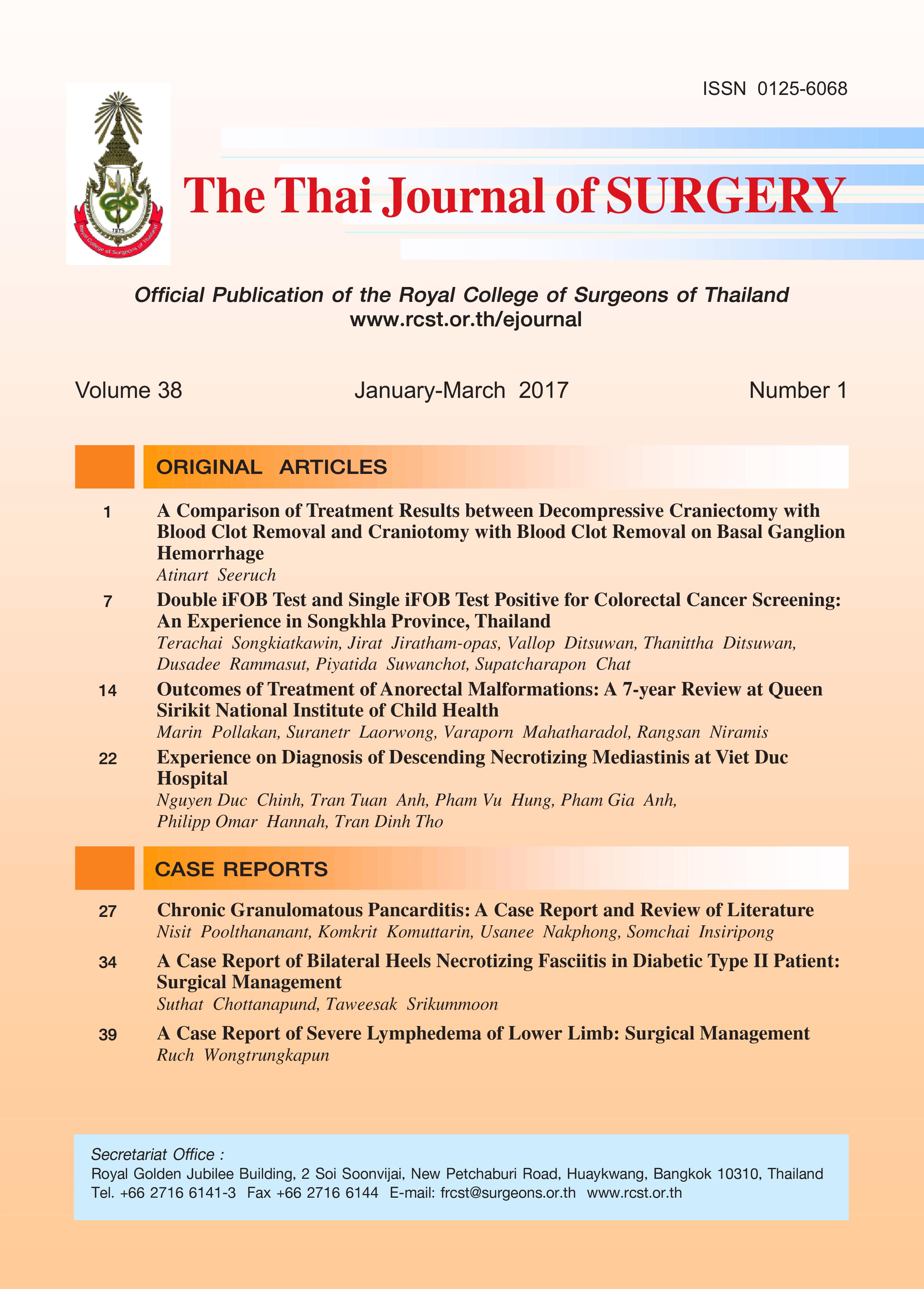Double iFOB Test and Single iFOB Test Positive for Colorectal Cancer Screening:An Experience in Songkhla Province, Thailand
Keywords:
Colorectal cancer screening, immunochemical fecal occult blood, fecal immunochemical test, reducing burden of colonoscopyAbstract
Objective: This study was aimed to determine single and double immunochemical fecal occult blood test (iFOB) positive rate, prevalence of colorectal cancer (CRC) in average risk individuals (ARIs), burden colonoscopy, and identifying constraints for implementing CRC screening.
Methods: This study was a cross-sectional design. The targeted population was ARI aged between 50-70 years old. Two areas, in Songkhla province, were randomly selected. Fecal immunochemical test (FIT) and colonoscopy were used as screence and diagnostic tests. In Hat Yai, participant received one iFOB test and colonoscopy was indicated for those with a positive FIT. In Na Mom, 1-3 iFOB were provided to each individual and colonoscopy was indicated for the participant with double FIT positive. The study proposal was approved by the Hatyai Hospital Ethical Committee (ID 11 (25/03/2015)) and proper treatments were provided to all CRC suspected case.
Results: In Hat Yai, 883 participants were recruited and FIT positive was 274 (31.03%) whereas 94 (34.31%) received colonoscopy. We found that 8 (9.06%), 1(1.13%), and 2 (2.27%) were small adenoma, advanced adenoma, and colon cancer. In Na Mom, 930 participants were enrolled. Only 13 (1.40%) participants were double FIT positive and 10 (76.92%) received colonoscopy. The results showed that 3 (30.00%), 2 (20.00%), and 2 (20.00%) were small adenoma, advanced adenoma, and colon cancer. CRC detection rate was 2.20/1,000 ARIs.
Conclusion: This study demonstrated superior colonoscopy participation rate for double FIT positive compared to single FIT positive. Double FIT positive screening strongly preferred over single FIT positive. It abruptly reduced colonoscopy invitee and similar CRC detection rate is reported.
References
2. Sriplung H, et al. Cancer incidence trends in Thailand, 1989-2000. Asian Pacific Journal of Cancer Prevention 2006;7:239.
3. Khuhaprema T, Attasara P, Sriplung H, Cancer in Thailand volume VII, 2007-2009: Bangkok.
4. Khuhaprema T, Attasara P, Sriplung H. Cancer in Thailand volume VIII, 2010-2012: Bangkok.
5. Khuhaprema T, Srivatanakul P. Colon and rectum cancer in Thailand: an overview. Jpn JClin Oncol 2008;38:237-43.
6. Frazie AL, et al. Cost-effectiveness of screening for colorectal cancer in the general population. Jama, 2000. 284(15): p. 1954-61.
7. Lieberman DA. Cost-effectiveness model for colon cancer screening. Gastroenterology 1995;109:1781-90.
8. Sharp L, et al. Using resource modelling to inform decision making and service planning: the case of colorectal cancer screening in Ireland. BMC Health Services Research 2013;13: 105.
9. Heitman SJ, Manns BJ, Hilsden RJ, et al. Cost-effectiveness of computerized tomographic colonography versus colonoscopy for colorectal cancer screening. CMAJ 2005;173:877-81.
10. Denters, M.J., et al., Implementation of population screening for colorectal cancer by repeated fecal occult blood test in the Netherlands. BMC Gastroenterology 2009;9:28.
11. Tappenden P, et al. Option appraisal of population-based colorectal cancer screening programmes in England. Gut 2007;56:677-84.
12. Hassan C, et al. Computed tomographic colonography to screen for colorectal cancer, extracolonic cancer, and aortic aneurysm: model simulation with cost-effectiveness analysis. Arch Intern Med 2008;168:696-705.
13. Pickhardt PJ, et al. Cost-effectiveness of colorectal cancer screening with computed tomography colonography. Cancer 2007;109:2213-21.
14. Quintero E, et al. Colonoscopy versus fecal immunochemical testing in colorectal-cancer screening. N Engl J Med 2012;366:697-706.
15. Rex DK, et al., American College of Gastroenterology guidelines for colorectal cancer screening 2008. The American journal of gastroenterology, 2009. 104(3): p. 739-750.
16. Sung JJ, et al. Increasing incidence of colorectal cancer in Asia: implications for screening. Lancet Oncol 2005;6:871-6.
17. Yeoh K-G, et al. The Asia-Pacific colorectal screening score: a validated tool that stratifies risk for colorectal advanced neoplasia in asymptomatic Asian subjects. Gut 2011:p. gut. 2010.221168.
18. Khuhaprema T, et al. Organised colorectal cancer screening in Lampang Province, Thailand: preliminary results from a pilot implementation programme. BMJ open 2014. 4:e003671.
19. Pignone M, et al. Cost-effectiveness analyses of colorectal cancer screening: a systematic review for the US Preventive Services Task Force. Ann Intern Med 2002;137:96-104.
20. Lieberman DA, et al. One-time screening for colorectal cancer with combined fecal occult-blood testing and examination of the distal colon. N Engl J Med 2001;345:555-60.
21. Chiang T-H, Lee YC, Tu Ch, et al. Performance of the immunochemical fecal occult blood test in predicting lesions in the lower gastrointestinal tract. CMAJ 2011;183:1474-81.
22. van Dam L, Kuipers EJ, van Leerdam ME. Performance improvements of stool-based screening tests. Best Pract Res Clin Gastroenterol 2010;24:479-92.
23. US Preventive Services Task Force, Screening for colorectal cancer: recommendation and rationale. Ann Intern Med 2002;137:129.
24. US Preventive Services Task Force, Screening for colorectal cancer: an updated systematic review. Rockville MD: Agency for Healthcare Research and Quality; 2008.
25. Official Statistics Registration System. Population and Household Statistics. 2015 [cited 2017 15 March 2017]; Available from: https://stat.dopa.go.th/stat/statnew/upstat_age.php.
26. Bretthauer M. Evidence for colorectal cancer screening. Best Pract Res Clin Gastroenterol 2010;24:417-25.
27. Hassan C, Pickhardt PJ, Rex DK. A resect and discard strategy would improve cost-effectiveness of colorectal cancer screening. Clin Gastroenterol Hepatol 2010;8:865-9.e3.
28. Heresbach D, et al. Cost-effectiveness of colorectal cancer screening. Gastroenterologie Clinique et Biologique 2006; 30:44-58.
Downloads
Published
How to Cite
Issue
Section
License
Articles must be contributed solely to The Thai Journal of Surgery and when published become the property of the Royal College of Surgeons of Thailand. The Royal College of Surgeons of Thailand reserves copyright on all published materials and such materials may not be reproduced in any form without the written permission.



